Archive for the 'Film industry' Category
Too many toons? Then why are they making so much money?
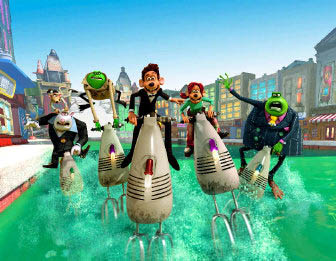
Kristin here—
Back in my December 10, 2006, entry, I discussed some reasons why CGI animated features often seem better than their live-action competition.
In passing I mentioned that industry news sources were discussing whether there were too many CGI films made last year. “Studio executives and commentators continue to debate whether there are now too many CGI films coming out. Indeed, the November 24 issue of Screen International says, ‘Much has been made this year of the seeming over-saturation of studios/computer-generated titles, with critics and analysts pointing to growing movie-goer apathy.’”
I realize that industry pundits have to have something to write about at year’s end. Unlike the critics, they don’t have the ten-best lists and who-will-win-the-Oscar options, so they assess box-office trends. One year indies suddenly are in, the next year the big sequels have surged back, and the next year the indies are back. To read the trade papers, one would think that trends come in neat one-year cycles. Maybe studio executives plan their upcoming films according to these supposed trends, but films being greenlit now will only appear years in the future. By then the cycles will have turned over and over.
The “too many toons” issue looks to me like a tempest in a teapot. If you look at the various box-office lists for 2006, CGI animation did better proportionately than live-action films did.
Let’s start at the bottom. The December 25-31, 2006 issue of Variety ran Nicole LaPorte’s “2006: H’w’d diagnoses its duds.” (I’d link to the online version, but it seems inexplicably to have disappeared from Variety.com.) There she talked about the 10 biggest failures of the year. Despite the title, the diagnosis and choice of films was done not by studio employees but by an “inhouse Variety poll.” To be included, films had to be relatively big-budget items that could plausibly have been hits on the basis of the track records of their directors, stars, or source material. (e.g., Lady in the Water, Poseidon, A Good Year).
One animated feature made the list: Flushed Away. I have already expressed my liking for this film and made some suggestions about why it undeservedly failed. Presumably it is a coincidence that DreamWorks’ head of marketing is leaving the company to set up on her own. She had presided over many hits for DreamWorks, and her new firm will continue to work with its releases. Still, the Variety story announcing the move refers to the lackluster performance of Flags of Our Fathers but does not mention Flushed Away or earlier Aardman films.
OK, so one of ten flops as designated by Variety staff members was a CGI feature. Nine of them are live-action films.
Now let’s go to the top of the list. The ten highest domestic box-office grossers in 2006 included four CGI hits: Cars, #2, Ice Age: The Meltdown, #7, Happy Feet, #8, and Over the Hedge, #10. On the worldwide chart, these four films rank high as well: Ice Age: The Meltdown, #3, Cars, #5, Happy Feet, #10, and Over the Hedge, #11. In the domestic market, 6 other toons make the top 100. So, 4 out of 10 toons are in the top ten, while 6 out of 90 live-action films make that short-list. I’m no math whiz, but that looks like 40% versus 6.6% to me.
Of course, as I pointed out back in the infancy of this blog, grosses aren’t the best measure of success. How much a film cost obviously determines how profitable it will be. Casino Royale, the #9 domestic box-office pull in 2006, took in $164 million—it is unanimously hailed as a hit, but it cost a reported $150 million to make. There’s also the factor of “prints and advertising”: how much it costs to order thousands of copies of a film and how much is put into the various forms of publicity. As I noted, P & A costs are seldom announced.
Recently, however, Kagan, a company with access to proprietary industry figures, put out its list of the 10 most profitable films of 2006. (Only films that “open wide” are included. That used to mean something like 500 or 600 theaters, but as more films come out on thousands of screens, the term has become pretty vague.) Kagan does factor in P & A expenditures alongside the filmmaking budget to determine a figure for a film’s total costs. It also has a formula to calculate the total income from all major forms of distribution: not just theatrical box-office, but DVD and the various other video and TV income for a film. The result is about as accurate a notion of profitability as we outside the industry are likely to get.
Going by Kagan’s reasonably reliable profitability figures, how do animated features stack up? We all know that CGI is expensive. A live-action feature that depends very heavily on computer trickery might spend as much as half its budget on special effects.
Surprisingly, CGI animation can be profitable. Kagan pronounced Ice Age: The Meltdown the most profitable film of 2006. With total production, marketing, and other direct costs of $256.4 million and an estimated $1.05 billion worldwide gross from all distribution channels, the proportion words out to 4.11 on the “Kagan Profitability Index.” (A film generally is assumed to be profitable if it achieves a KPI rating of 1.75 or more.)
Three other animated films made the top ten on the Kagan KPI list: Cars was the 8th most profitable film, Over the Hedge the 9th, and Happy Feet the 10th. These figures are all the more remarkable when one considers that a high proportion of tickets sold for animated films tend to be at the lower children’s admission prices.
The real question isn’t really whether there are too many animated features coming out. It’s actually how large the G and PG markets are. Live-action films come in all ratings, so they are not all competing with each other. R-rated horror films compete with other edgy teen-oriented movies but not with family-friendly holiday movies. Toons tend to compete with each other, but they also compete with G and PG live-action films. Flushed Away was not done in because it opened on the same weekend as another CGI toon. It presumably sank partly because it was released on the same day as The Santa Clause 3.
In 2006, live-action films for children didn’t do as well among domestic grossers as animated ones did. Night at the Museum was #5 with $205 million, but the next highest film of this type, The Santa Clause 3, took in $84 million to end up at #22.
Bottom line—and that’s what we are talking about here—there doesn’t seem to be a glut of animated films so far. Let’s see what Shrek 3 and the other CGI toons of 2007 lead the pundits to diagnose a year from now.
Updates and outtakes (in which we try, perhaps in vain, to catch up with ourselves)
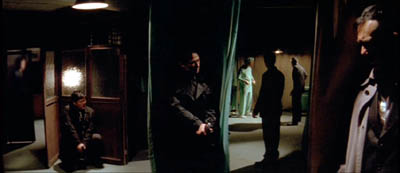
Exiled
Kristin writes:
“The Hobbit Film: New Developments” (January 13, 2007)
In this entry I discussed Bob Shaye’s recent claim that Peter Jackson would never get a chance to direct The Hobbit for New Line. I mentioned that one of the factors involved in the negotiations about who would direct is that the production rights will eventually revert to producer Saul Zaentz. I didn’t know the length of the option on those rights, which New Line currently holds. The January issue of the fantasy/sci fic magazine Locus says that the rights will revert to Zaentz in 2009.
Zaentz had owned the rights since the mid-1970s and sold them to Miramax in early 1997. Miramax had the two-film version of The Lord of the Rings in pre-production for about 18 months and then sold the rights to New Line in August of 1998. I don’t know what the source of Locus’ information is, but a twelve-month option would seem pretty plausible.
If that information is correct, New Line only has about two years to get the actual making of the film underway. It takes years for any big film to lumber into production in Hollywood these days, so the studio doesn’t have a lot of room to wiggle.
“By Annie Standards” (December 14, 2006)
Here I talked about methods for publicizing animated features. One way, I suggested, would be to foster audience interest in the various animation awards other than the Oscars. I remarked, “Under Academy rules, only three animated features can be nominated in any year unless sixteen or more such features are released that year. Then the number of nominations jumps to five, but so far that hasn’t happened. It may finally happen this year, if all sixteen features currently under consideration qualify under Academy rules.”
Close, but not close enough. On January 11, Variety announced that one film, Luc Besson’s Arthur and the Invisibles, had been disqualified as an animated feature. To qualify, a film must have at least 75% animated footage, and Arthur has too much live action.
With the number of qualifying features down to fifteen, only three can be nominated. Probably Cars will win, as I predicted in the original entry. It just won the Golden Globe in the newly established Animated Film category.
“Snakes, No, Borat, Yes: Not All Internet Publicity Is the Same” (January 7, 2007)
Here I suggested some reasons why Snakes on a Plane failed at the box office and Borat: Cultural Learnings of America for Make Benefit Glorious Nation of Kazakhstan succeeded, despite the fact that both garnered considerable fan-generated publicity on the internet. I mentioned that Sacha Baren Cohen had appeared on talk shows in character as Borat rather than in persona proper: “Each appearance by “Borat,” supposedly there to talk about the film, ended up being a hilarious performance by Cohen, ad-libbing on everything around him—the chairs, the coffee mugs, the cameras, the audience. Spectators ended up with one impression about the film: it was about this incredibly funny guy doing incredibly funny things.”
Trying to correct the widespread assumption that Borat was an improvised film, the January 8-14 issue of Variety ran a story about how Cohen worked with three scriptwriters, Peter Baynham, Dan Mazer, and Anthony “Ant” Hines: “The scribes even concoct Cohen’s dialogue for his promo appearances on ‘The Tonight Show’ and ‘Live With Regis and Kelly.’” Although Cohen presumably ad-libs to meet specific circumstances of each talk show, the publicity appearances are even more controlled by Cohen than I had assumed.
I also remarked that it is difficult to judge the degree to which the film manipulated the scenes of Borat’s encounters with real people. Especially in terms of editing and sound techniques, there was clearly much opportunity for this manipulation. The same Variety story goes on to say, “Much of the script had to be altered depending on how situations unravel. This means the writers ultimately end up producing the equivalent of multiple scripts, much of which ends up on the cutting room floor.” I’m not sure how chunks of scripts can end up on the cutting-room floor, but the point is that the filmmakers were carefully stitching the “documentary” scenes together on the script level and presumably would do so through stylistic means as well.
David writes:
Back to the Hotel
The Uchoten Hotel (aka Suite Dreams, blogged here) has acquired yet another English-language title: Hotel Avanti. It made it to #93 on Variety‘s list of the world’s 100 top-grossing films, with $51 million box office in Japan and none yet recorded overseas.
Speaking of Variety‘s list, the highest-grossing non-English language item turns out to be Bong Joon-ho’s Korean hit The Host (#59 at $84 million), due out in the US any month now. Only ten non-English-speaking films made the top 100, and of those, three were European (including Volver) but all the rest were Asian: Chinese (Fearless), Korean (The Host and King and Clown), and Japanese (Tales from Earthsea, Umizaru 2 Limit of Love, Hotel Avanti, and Japan Sinks–no rude remarks, please).
The entire list is in the 15-21 January hard copy of Variety, p. 15, but evidently it isn’t yet available on the paper’s site.
More on Johnnie To
In an earlier blog I praised Johnnie To as a director who shot and cut PTU smoothly and crisply. I waited through the fall, hoping somehow to see To’s latest, Exiled, on the big screen at one festival or another. No such luck. So last night I broke down and watched the DVD. Making full use of the widescreen format, To shows that classic technique can be at once rigorous and imaginative.
Exiled was more visually engaging than any US film I can recall last year, including Miami Vice. It immediately became my Best Film of 2006 That I Saw in 2007. (Runner-up: Children of Men.) I visited Milkyway while the film was being shot, and I hope to blog about the result in a future entry.
At Large on the Internets
On this very site, I’ve posted a new essay on action movies.
Annie Frisbie interviewed me for the Zoom-In podcast here. Annie is also blogging/reviewing Sundance films here.
Fox Independent visited Madison and posted videos on its site. The setup and the interview with filmmaker and teacher Erik Gunneson are here. An interview with me is here.
The Hobbit Film: New Developments

(Photograph by Emma Abraham)
Kristin here–
Behind closed doors, major negotiations and offers concerning the film of The Hobbit are presumably passing back and forth. The glimpses afforded the public via the key players suggest a stormy process. One of those players, Bob Shaye, is president of New Line Cinema, which he founded in 1967 and has headed ever since. He was the one who in 1998 took on the Lord of the Rings project and decided to make the film in three parts.
On January 10th, a report posted on the internet quoted Shaye as declaring that Peter Jackson will never get to direct The Hobbit for New Line.
That’s quite a leap from the situation as it was back on October 2, when I posted my first blog on the subject. At that point MGM (which owns the distribution rights for The Hobbit) had just announced that it and New Line would co-produce the film. The studio’s spokesperson mentioned Jackson as the director of choice.
The big concern among fans then was whether Jackson, who had been announcing new producing and directing projects right and left, would have time in his schedule to tackle such a major project—especially given that MGM suggested that the film might be made in two parts.
Having written a book, The Frodo Franchise, with the cooperation of the filmmakers, I weighed in on the logistics of all this. As I said at the time, since finishing my research in New Zealand in 2004, I have not had direct contact with Jackson or the others privy to the negotiations concerning his subsequent projects. I simply offered an educated opinion on the situation and why Jackson might well be able to fit The Hobbit into his schedule. The recent major developments suggest that it’s time again to provide some additional context.
One fundamental bit of backstory on the whole issue of who will direct The Hobbit dates back to early 2005, when Jackson filed a lawsuit against New Line. The entire complaint, published March 25, 2005, is available online. It makes a number of claims concerning New Line, including ways in which the exploitation of The Fellowship of the Ring and its licenses was dealt with. Primarily it alleges that New Line did not “properly account, calculate and pay to Wingnut its share of the profits” (i.e., from theatrical distribution) and didn’t “properly allocate license fees paid with respect to packages of defendants’ film properties that include the Film.” I take it that the latter refers to the DVDs. Jackson insists that the lawsuit does not demand a set amount of money but simply a proper auditing of the money from the Fellowship release, licensed goods, and DVD.
On November 19, 2006, Jackson and producing/writing partner Fran Walsh posted a letter on TheOneRing.net. In essence they said that they had been approached by New Line to make The Hobbit, with the implication that the lawsuit would be settled if they accepted. Jackson and Walsh countered by saying that they would not link the film to the lawsuit. New Line decided to find another director, and Jackson and Walsh told the fans they would not be making The Hobbit.
There followed a storm of protest on the Internet. MGM pointed out that it still wanted Jackson to direct The Hobbit. Saul Zaentz, who had sold the production rights back in 1997, said he hoped that Jackson would direct.
At that point, an observer might reasonably assume that the participants were drawing lines in the sand. Jackson clearly wanted to direct The Hobbit, but he had plenty of other projects in the pipeline and did not need to chase this one. Perhaps he saw the November 19 announcement as a way to pressure New Line into settling the lawsuit. Perhaps New Line suspected that they would end up owing Wingnut a great deal of money if the audit occurred.
There the situation evidently stood for nearly two months, with no public signs of either side budging. Then, in a brief interview with Sci Fi Wire (the news service of the Sci Fi Channel’s website) posted on January 5, Shaye declared: “I do not want to make a movie with somebody who is suing me. It will never happen during my watch.” Shaye declared that Jackson had so far been paid “a quarter of a billion dollars,” implying that suing for more was greedy and again emphasizing: “He will never make any movie with New Line Cinema again while I’m still working for the company.” Wingnut’s deal with New Line for producing, directing, and writing LOTR involved flat fees for Jackson and Walsh as well as an undisclosed percentage of the income and bonuses if the film hit certain box-office levels.
Later the same day, Jackson responded on Ain’t It Cool News, briefly reiterating in measured terms the reasons for the lawsuit and expressing regret at Shaye’s statement.
Where do things stand now?
According to the November 19 letter, Mark Ordesky (Executive Producer of LOTR) was the one who called Jackson about The Hobbit. In the course of it he mentioned that the option on the production rights for the novel would eventually revert to Saul Zaentz. Hence New Line’s need for speed and its decision to seek another director. Rumors that Sam Raimi had been approached circulated, though no evidence for that has surfaced.
It is customary for production options on a literary property to be sold for a limited time. Given that we just passed the tenth anniversary of Zaentz’s sale of the rights, obviously that wasn’t the period. Who knows how many years are left? Is New Line using that issue as a way to put pressure on Jackson? Quite possibly.
New Line must realize that Jackson’s name adds tens of millions of dollars in value to The Hobbit as a film property. Its executives know that fans are up in arms about all this. A poll taken by TheOneRing.net beginning December 18 asked whether fans would go see The Hobbit if it were directed by someone other than Jackson. “Definitely No—No way without PJ!” garnered 62.5% of the votes; “Not likely—I can’t imagine another team involved” drew 14.1%; “Very likely—Can’t wait for any live-action Hobbit film!” 10.3%; “Don’t know—Depends on who directs,” 10.3%; “Likely—It is time for some fresh creative juices,” 2.6%. 10,143 people voted, thousands higher than in other recent TORN polls.
Clearly indignant fans would be more likely to participate in such a poll than would non-indignant ones. And no doubt many of the fans would change their minds and go to The Hobbit as directed by someone else. Still, considerable resentment would linger and be volubly expressed right up to the time of the film’s release. Any director approached by New Line would doubtless be aware that he (or possibly she) would be swimming upstream against a flood of fan opprobrium. Would any major director agree to it? Some of the likeliest candidates are also friends of Jackson’s.
Another relevant factor that New Line would have to consider is whether any of the actors would return to work under a different director. Jackson creates a fierce loyalty among the people he works with. During the making and release of LOTR, the actors rallied behind him during a number of disputes with the studio.
On November 22, Ian McKellen put the Jackson/Walsh letter on his series, “E-Post: The Lord of the Rings” and added a comment: “The LOTR fans are already expressing a sense of betrayal. On my own account, I am very sad as I should have relished re-visiting Middle Earth with Peter again as team-leader. It’s hard to imagine any other director matching his achievement in Tolkien country. We will have to await developments but being an optimist I am hoping that New Line, MGM and Wingnut can settle outstanding problems so that the long expected ‘Hobbit’ is filmed sooner rather than later.”
Of course not all that many characters in LOTR appear in The Hobbit. Gandalf is the crucial one, and McKellen strongly implies that he wouldn’t return under another director. Elrond appears in two brief episodes. (The general opinion is that Ian Holm would be too old to play Bilbo, who is 50 in the novel.) Jackson has mentioned the possibility of showing the White Council meeting, which is only mentioned in the book, and that would involve at least Galadriel and Saruman. It is quite possible that the relevant actors would refuse to return unless Jackson helms the film. Important crew members might do the same.
The possibility of the rights reverting to Zaentz remains vague unless someone reveals the length of New Line’s option. I suspect that Zaentz would like nothing better than to regain those rights. He is a formidable producer himself, having three Best Picture Oscars on his mantel (One Flew over the Cuckoo’s Nest, Amadeus, and The English Patient). He got a very significant cut of the gross income from Lord of the Rings, as well as loads of money from the licensed products. By producing The Hobbit himself, he would probably receive a considerably higher cut.
He also wouldn’t have to depend on New Line’s accounting practices. Zaentz himself sued New Line over his share of the box-office take for LOTR. His suit alleged that although his contract gave him a cut of the gross theatrical income, New Line had calculated his share on net revenues, paying him $168 million. The trial was set to commence on July 19, 2005, but New Line entered into negotiations and settled with Zaentz in August, giving him an additional $20 million.
Lawsuits like this aren’t uncommon in Hollywood, so the Jackson/Walsh and Zaentz claims against New Line are not extraordinary events. The Zaentz case does, however, give some indication of the kinds of money involved. It is notable that New Line has caved as a result of a lawsuit somewhat similar to the one now in contention.
Presumably Jackson and Walsh’s suit will eventually make it to court if New Line does not do as they did with Zaentz and settle it. Thus the advantage of shutting Jackson out of the Hobbit project doesn’t seem apparent to an outsider. They’ll face it at some point—why not bite the bullet, settle, and regain access to the one director virtually guaranteed to make this valuable literary property into a huge hit?
The success of LOTR went beyond any of its makers’ most optimistic expectations. That success was largely due to Jackson and Walsh. They were the ones who brought the project to New Line, which otherwise would have had no way of getting the novel’s production rights. The first film came out in a year that was perhaps the worst the studio had ever endured. In January, 2001, cutbacks imposed by AOL Time-Warner, New Line’s owner, had forced Shaye to let go a hundred employees. This was not a minor thing for such a small company, and one which was known for its long-term retention of a tight-knit staff. In the spring of 2001 New Line had two of its most costly failures with the Adam Sandler comedy Little Nicky and the infamous Town and Country. The December release of Fellowship pulled New Line out of a huge slump. It is probably not true, as many predicted at the time, that the studio would have ceased to exist had it not been for LOTR. It does seem likely, though, that Shaye would have had far less autonomy and power in running the company that he had started.
I discuss the events of that period in detail in The Frodo Franchise. At this point, the fracas seems odd indeed, both from a personal and a financial point of view. There may be other factors involved that those not apparent to outsiders, and we may well never learn what those were.
In the meantime, the actors involved grow older. Ian McKellen went to New Zealand and began playing Gandalf in January of 2000, when he was 60. Last year, at 66, he predicted, “I’ve got another 10 years in me, probably, of capering.” In the same interview he remarked, “I would love to do ‘The Hobbit,’ yes. Partly because I would hate to see anybody else playing Gandalf.”
So would just about anyone else.
[Added August 6: For my earlier comments on the Hobbit project, go here.
Uncle Walt the artist
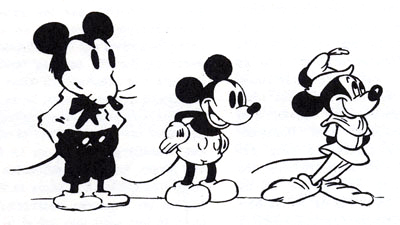
From Robert Benayoun, Le Dessin animé après Walt Disney.
The epos of Chaplin is the Paradise Lost of today. The epos of Disney is Paradise Regained.
Sergei Eisenstein
DB here:
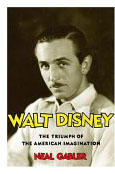 I’m not qualified to write a comprehensive or penetrating review of Neal Gabler’s biography Walt Disney: The Triumph of the American Imagination. For that you can go to Mike Barrier, one of our finest historians of US animation. Barrier’s own Disney biography will come out this spring, with apparently little overlap with Gabler’s.
I’m not qualified to write a comprehensive or penetrating review of Neal Gabler’s biography Walt Disney: The Triumph of the American Imagination. For that you can go to Mike Barrier, one of our finest historians of US animation. Barrier’s own Disney biography will come out this spring, with apparently little overlap with Gabler’s.
I found Gabler’s book a thorough, somewhat cautious bio, even-handed about Disney and judicious about such controversial matters as Walt’s reputation as an anti-Semite. A lot of it reads like a notecard book, with quotes, paraphrases, and commentary dutifully snipped and pasted in, packing each paragraph. Chronology, not concept, rules. Still, I learned a lot.
Gabler’s book reminded me how much I admire Disney films. The attachment started–as for most of us–in childhood. Peter Pan (1953) was the first one I remember seeing in a theatre, but when I saw a reissue of Snow White later, parts looked so familiar that it must have impressed itself on me at an earlier time. Of course it still scared the hell out of me.
In 1973, when I was doing dissertation research in New York City, I attended a massive Disney retrospective at MoMA. As a twenty-five-year-old bearded guy among moms and kids, I felt obscurely criminal just being there, like a character in a Patricia Highsmith novel. But what I saw, in excellent prints, showed me that Disney was important on both cultural and artistic levels. So I designed a Disney unit into my first Introduction to Film course, taught here at University of Wisconsin–Madison to 300-400 souls whom fate cast my way.
I wanted to talk about film’s relation to society, and Disney was a touchstone for all my students. No matter where they came from, they knew Mickey, Donald, Snow White, Fantasia, and the rest. I showed early films, like Flowers and Trees, The Band Concert, and The Old Mill, as well as a True-Life Adventure nature doc, and the extraordinary Trip through the Disney Studio which was originally attached to The Reluctant Dragon. Students were able to see, I hope, how the ideology at work in Disney films could shape a conception of the world, of American life, and of their childhood.
Our assigned reading was Richard Schickel’s The Disney Version (1969); it’s a coruscating study, perfectly crystallizing that era’s feelings about Disney’s debasement of popular culture. At about the same time, Armand Mattelart’s Marxist critique How to Read Donald Duck was informing most film academics’ study of Disney. As Gabler indicates, intellectuals fell out of love with Disney in the 1940s. He handled labor disputes at the studio in a high-handed, paranoid way. He also seemed to personify the blandness of postwar consensus culture, and Disneyland became the theme-park equivalent of Norman Rockwell Americana. Even though hippies were turning on to re-releases of Alice in Wonderland and Fantasia, most cultural critics treated Disney pretty roughly. My friends and I goggled at Wally Wood’s 1967 Realist cartoon showing Walt’s whole gang engaging in a panoply of naughty sexual encounters.
Today the academic study of Disney is well-established, producing far too much for me to keep up with. A lot of it is cultural critique. For something funnier and even more scurrilous, see Carl Hiaasen’s Team Rodent. Despite all there is to read about Walt’s empire and its cultural consequences, I want something else as well.
Even when I was conducting my Disney Demystification Exercise, I tried to point out that these cartoons were artistically very strong. I still admire the powerfully emotional storytelling that, like that found in other fairy tales, preys so mercilessly on childhood fears. Schickel claims that after screenings of Snow White at Radio City Music Hall, the seats had to be cleaned because the Witch had scared kids into emptying their bladders.
Then too there’s the dynamism and grace of the animation, which remains unsurpassed. For Sergei Eisenstein Disney exemplified the contagious power of expressive movement on the screen. Many have disdained “Mickey-Mousing,” the close matchup between a film image and the accompanying music. But Eisenstein saw this as “synchronization of senses,” a primal, visceral unity that could move the spectator involuntarily. He sought this subconscious synchronization in his own sound films, and Alexander Nevsky and Ivan the Terrible show the strong influence of Disney.
Eisenstein was well aware of the delusional aspects of Disney, claiming that the cartoons lulled people into forgetting the harm done by capitalism. But as an artist, Disney was unique:
I’m sometimes frightened when I watch his films. Frightened because of some absolute perfection in what he does. This man seems to know not only the magic of all technical means, but also all the most secret strands of human thought, images, ideas, feelings…. He creates somewhere in the realm of the very purest and most primal depths.[1]
Disney’s art seems magical, but if it’s not a miracle, we ought to be able to study it systematically. How?
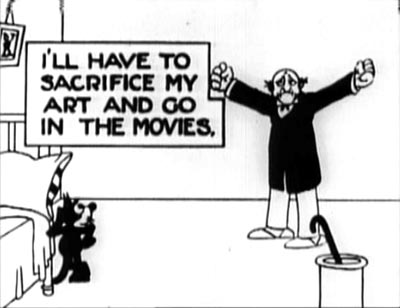 Felix in Hollywood (1923)
Felix in Hollywood (1923)
For the Jung at heart
Gabler’s is a sturdy, readable volume teeming with fascinating background material. As an EEG of the ups and downs of the studio, it’s extremely valuable. Gabler also aims to give a portrait of Disney the visionary, a man of boundless Protestant energy who sought to take animated film to ever higher levels. I think the portrait is disappointing, though, in its reliance on conventional psychobiography and Zeitgeist explanations.
Disney, Gabler claims, was dominated by a psychological drive to create a world wholly of his own. He was a control freak. “It had always been about control, about crafting a better reality than the one outside the studio, and about demonstrating that one had the capacity to do so. That was what Walt Disney provided to America–not escape, as so many analysts would surmise, but control and the vicarious empowerment that accompanied it.”
Commentators have long noted that Disney expanded the films’ fantasy world in his theme park. Just as films idealized reality, “so would Disneyland, the creation of a wounded man who expunged what he saw as the darker passages of his past by devising a better world of his imagination, though one that was obviously colored by the images of Hollywood.”
One has to wonder whether this characterization is particular to Uncle Walt. Lots of artists, from architects and topiary gardeners to designers of world’s fairs, have sought to create imaginary worlds over which they rule. Balzac, Faulkner, Lewis Carroll, and J. R. R. Tolkien conjured up imaginary realms populated by dozens of their own creatures. Graphic artist Ho Che Anderson writes:
For the control freak, there are few places better than comics. . . . Pick up a pen and piece of paper and you too can effectively play God. I suspect this love of God-play is the blood that keeps the hearts of many a cartoonist beating.[2]
Moreover, is the desire to build a parallel world necessarily a sign of a wounded past, or dark imaginings? Maybe it’s just one awesome creative challenge for ambitious artists. Granted, Disney took this impulse in a particular direction, toward a vision of life combining technical progress (the multiplane camera, Tomorrowland) with idealized notions of small-town community. But then we have to explain those idiosyncratic factors too.
Gabler goes the psychological route, but we could balance this account with cultural factors in Disney’s immediate milieu. There was the rise of the Technocracy movement. There was Hollywood’s belief that filmmaking would progress through new technologies. There was growing evidence during and after World War II that America’s might would be built on new machines. (One of the most hair-raising movies I saw at the 1973 MoMA Disney fest was Victory through Air Power, an educational short arguing for investment in airborne warfare.) Disney was, along many dimensions, a techie impresario, the Steve Jobs of his day, complete with his unique reality-distortion field.
The other big-picture explanation Gabler offers is a Zeitgeist model. Disney represents the American imagination. By tapping into Jungian archetypes, his 1930s films could both “capture and then soothe the national malaise.” More generally: “In both Disney’s imagination and the American imagination, one could assert one’s will on the world . . . . Indeed, in a typically American formulation, nothing but goodness and will mattered.” Disney’s desire to retreat into a controlled world echoes his country’s self-absorped conception of itself.
Despite these claims, Gabler doesn’t dwell much on the ways the studio seized what he calls “the American psyche,” perhaps because he senses that such explanations tend to be uninformative. One can grab almost any cluster of traits, find them in American popular art, and assert them as quintessentially American. This is how mainstream journalists make current Hollywood releases worth writing about: treating them not as artworks with distinctive appeals and a place in traditions and histories, but as reflections of whatever immediate social trends the writer chooses to pick out.
I won’t extend my criticism of Zeitgeist explanations here; it’s developed in the first essay in my forthcoming Poetics of Cinema. I’ll just say that I think we need more precise explanations than we get from easy juxtapositions of this or that film and some collective mood, sentiment, fantasy, or anxiety that we postulate as existing out there. Is there an American psyche? I’m not convinced.
An alternative to psychological speculation and Zeitgeist thinking is to look for more immediate causal connections. For example, Gabler traces how, around 1932, Disney began a new division of labor among his staff. He created a fairly strict set of specialties (story, gags, continuity sketches) and a chain of command in which head animators would become directors, overseeing particular projects. What’s the explanation of this change of policy? For Gabler, the new rationalization reflects not only the need to manage a bigger staff but also Walt’s effort in “reinventing and perfecting the system under which animations were produced.”
Gabler doesn’t mention that reorganizing the division of labor was going on throughout Hollywood at the same time. Most major studios were moving from a central producer system (this parallels the previous Disney lineup, with Walt at the top) to what Janet Staiger has called the producer-unit system, in which each man was charged with several productions.[3] Mentioning this doesn’t take away from Disney’s resourcefulness, but it does indicate that models for organizing his company were emerging right under his nose.
Similar issues could be examined by looking at Disney’s place in the overall ecology of Hollywood, as the premiere supplier of short subjects. His firm, Douglas Gomery argues, kept RKO afloat for many years. Gomery’s Hollywood Studio System: A History gives a cogent account of Disney’s role in the industry, and he goes somewhat beyond Gabler in tracing the studio’s emergence as in the 1950s as the prototype of modern conglomerate filmmaking.
Life in the cel
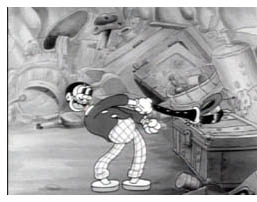 For Gabler, what made Walt reorganize production, and indeed what made him do nearly everything, was his obsessive pursuit of “quality” animation. But this quality itself remains fairly mysterious.
For Gabler, what made Walt reorganize production, and indeed what made him do nearly everything, was his obsessive pursuit of “quality” animation. But this quality itself remains fairly mysterious.
Gabler indicates that Disney moved away from the “rubber-hose” style of most cartoons, with their balloon heads, swollen paunches, and elastic arms and legs. (Even the clarinet goes limp in Harman-Ising’s A Great Big Bunch of You, from 1932, shown here.) Floppy limbs were fairly easy to animate. Gabler briskly summarizes Team Disney’s well-known innovations in naturalism, such as the studio’s emphasis on anatomy and life drawing, the breakdown of gestures, complex perspectives, and the rotoscoping of human figures.
Yet Gabler, a former movie critic for television, oddly doesn’t engage with the result of the technical innovations. He summarizes how journalists, critics, and academics have interpreted the movies’ cultural impact, but what he thinks about them as movies, rather than social or psychological symptoms, is almost completely suppressed. Does he admire Snow White or Dumbo or Pinocchio? Does he hate them? Has he studied them in preparation for the book? You will find more sensitive appreciation and critique in Leonard Maltin’s The Disney Films than in all of Gabler’s doorstop tome.
Gabler implicitly acknowledges the technical achievements of Snow White, Pinocchio, Fantasia, Dumbo, and Bambi, but after that he merely chronicles release after release with deadpan indifference. For example, he offers us nothing on the brilliant character animation of Song of the South (1946)–a film no longer in circulation because of its racial stereotyping.
Gabler follows tradition in suggesting that the UPA studio movies challenged Disney’s hyperrealism, but Disney was already moving toward something quite stylized. Gabler doesn’t observe the zesty play with color and line of Melody Time‘s “Blame It on the Samba” episode (1948). Eisenstein would have been pleased to see that the handling of Donald and Jose literalizes the metaphor feeling blue.
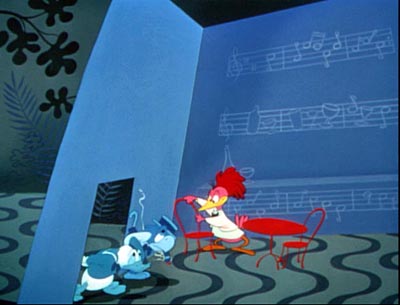
Working with lower budgets in the 1940s, the animators let their imaginations run wild. What a pleasure it must have been for Ward Kimball to come up with the funhouse nuttiness of the Serape song in The Three Caballeros (1945).
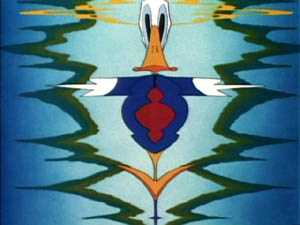

Kimball must have been quite a character; his parody book Art Afterpieces doesn’t spare the studio’s creatures. More generally, when Disney animators turned to illustrating pop music, they didn’t abandon the wilder sides of Fantasia.
There would be several fruitful ways to study the Art of Uncle Walt. One would require what I call rhapsodic criticism, writing that tries to evoke the movie’s look and feel through energetic, sensuous description. (This is, I think, what Susan Sontag meant in calling for “an erotics of art.”) Here is Don Crafton on the Felix the Cat cartoons:
Perhaps the most appealing aspect of Felix was his use of expressive body parts–a tail that forms gratuitous curlicues when he walks, or ears that click together like scissors. . . . He can mold himself into a mantel clock and have his nose mistakenly wound up; his tail can be an umbrella, a sword, or a clarinet, or Chaplin’s cane. He can use the tail as a bow to play a tune on his whiskers, then take one of the rising notes and use it for a doorkey. His skin is detachable. In Felix Trifles with Time (1925), a tailor flays him, then outfits a client with his pelt. When the man goes swimming, “naked” Felix retrieves his hide from the beach. [4]
In brief compass Crafton brings Felix alive for us. You don’t have to love Disney to write this way about his films; you do need a good eye, some pluck and gusto, plus a gift for language. Nothing like this is to be found in Gabler’s book.
Another way to get closer to Disney’s art is to just look at things more analytically. How does Disney create that expressive movement that Eisenstein admired? Partly, it seems, through having his figures move all over, and at the same instant. Reacting to a line of dialogue, a character can twist his waist, arch his back, swivel his shoulders, lift his head, arch his eyebrows, and raise a forefinger–all in a second or two. Two successive frames from Melody Time show Johnny Appleseed’s guardian angel in action, working his legs, arms, shoulders, jaw, and eyeballs simultaneously.
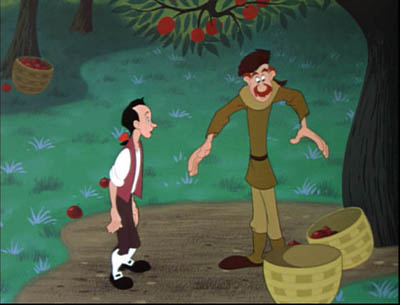
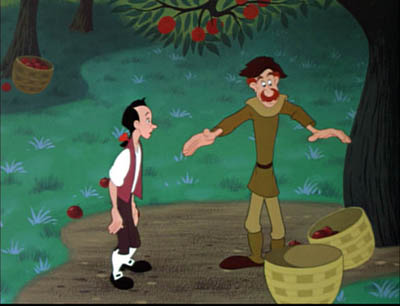
This is far from the minimal animation to which we became accustomed in the TV era. Treating gesture as a taut, rolling movement helps give Disney characters their unique volume and springiness, so different from the flabby postures of the rubber-hose style.
Or consider pacing, at which the Disney cartoons excel. Most studio animation of the period, constrained by smaller budgets than Disney had, speeded up production by filming each frame twice. That way only 12 cel drawings were needed for the 24 frames that consumed a second of film. One way Disney achieved expressive action, and the high quality to which Gabler refers, was to devote single frames–and cels–to details of particular movements. This choice, though expensive, allowed for exact adjustments in rhythm.
Sometimes there’s more than one movement per frame. You can occasionally find this strategy at work in other studios’ cartoons too, as Kristin has explained in an essay she mentions elsewhere in our blog. But Disney’s animators certainly used the technique with great panache. When Johnny, balancing on a branch, is caught in a rain of apples, he sweeps them up with lighting speed–a deft swirl made possible by multiplying character poses on each cel. If that means giving Johnny many arms and even detaching his hands, so be it.
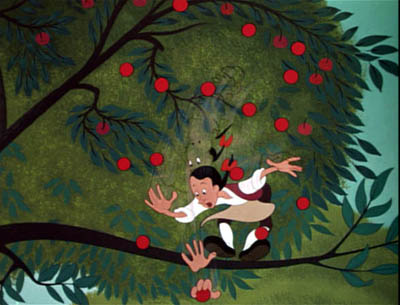

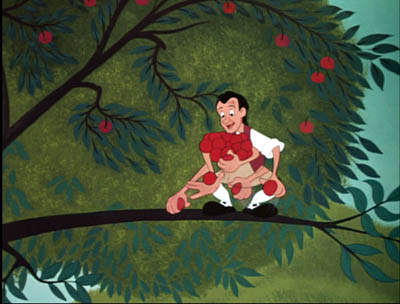
Johnny’s arms and hands proliferate more quickly and widely as he scoops up the apples, but their number is reduced as he gathers them in to his chest, so the rhythm accelerates and decelerates. Through trial and error Disney’s animators learned that rather strange single images will look exactly right on the screen; these men were practical perceptual psychologists.
There are so many aspects of Disney’s art that need attention: the skill with line and contour; the sort of soft caricature that some consider cutesy but has enormous bounce and vibrancy; the ingenious use of color; and of course, Eisenstein’s “synchronization of senses” between image and music. There’s also Disney’s appropriation of developing live-action techniques, as in the proto-Wellesian crane shot in Pinocchio
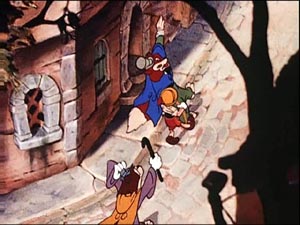
One could also study the studio’s borrowing of high-art motifs and styles. Instead of dismissing the 1940s and early 1950s Disneys as greeting-card kitsch, we can note that they evidently borrowed from the likes of WPA landscape art, American regionalist painting, and the naive-art look of Grandma Moses. (Her painting A Beautiful World, 1948 resembles Disney’s Johnny Appleseed of the same year.)
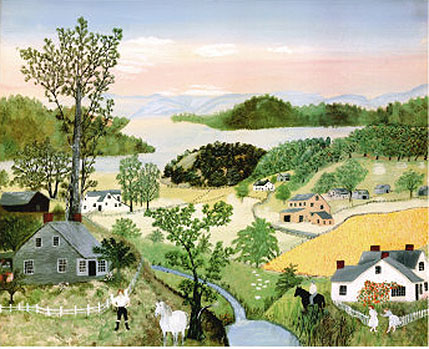

I’m a duffer in animation matters, so I’ve merely indicated some areas that intrigue me. The key source on the studio’s craft practice remains the gorgeous book The Illusion of Life: Disney Animation (1981, rev. 1995), by two of the great Nine Old Men, Frank Thomas and Ollie Johnson. And I expect lots of discoveries in years to come from experts like Barrier, Maureen Furness, Paul Welles, Norman M. Klein, and many others. Since Gabler draws heavily on the research of others, often without naming names, he might have borrowed a bit more from scholars of animation aesthetics.
In fact, you could argue that without the artistic imagination displayed by Disney and his brilliant staff, these films couldn’t have captivated the American imagination. Whatever that is.
[1] Eisenstein on Disney, ed. Jay Leyda, trans. Alan Upchurch (Calcutta: Seagull, 1986), 2.
[2] “Career Tips for Control Freaks,” in The Education of a Comics Artist, ed. Michael Dooley and Steven Heller (New York: Allworth, 2005), 124-125.
[3] Janet Staiger, “The Producer-Unit System: Management by Specialization after 1931, in David Bordwell, Janet Staiger, and Kristin Thompson, The Classical Hollywood Cinema: Film Style and Mode of Production to 1960 (New York: Columbia University Press, 1985), 320.
[4] Donald Crafton, Before Mickey: The Animated Film 1898-1928 (Chicago: University of Chicago Press, 1993; orig. 1982), 327, 328.













